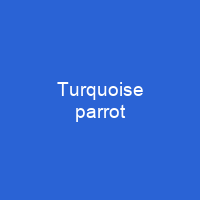The Turquoise Parrot: A Gem of Eastern Australia
Imagine a parrot with a face that shimmers like the turquoise sea, its wings a blend of blue and red, and its body adorned in vibrant green and yellow. This is the Turquoise Parrot (Neophema pulchella), a species native to Eastern Australia that has captivated bird enthusiasts for generations.
Physical Characteristics
The turquoise parrot is a small, colorful bird with a unique appearance. Its green upperparts and yellow underparts are complemented by its bright turquoise-blue face, making it stand out in the Australian landscape. Males have a predominantly blue wing patch with red shoulders, while females are duller and paler, often described as more uniform in their coloring.
But what about those juveniles? They’re like young versions of the adults, but with less extensive blue on their faces. It’s fascinating to see how they develop into these vibrant beauties over time!
Natural Habitat and Behavior
The turquoise parrot inhabits open woodland and savanna woodland in southeastern Australia, including New South Wales, Victoria, and parts of Queensland and South Australia. These birds are sedentary and do not migrate, except for some nomadic populations following water availability.
During the breeding season, males perform courtship displays by extending their wings to show off red and blue markings. Females choose breeding sites using vertical or nearly vertical hollows of live and dead eucalyptus trees, often located in open woodland. Breeding takes place over warmer months with eggs laid from August to January.
Chicks are altricial, covering their eyes in 7 days, and fledge at around 23 days old in the wild, with up to 56% successful fledging. These birds congregate into pairs or small groups during breeding season, roosting communally at night among foliage 1-8m above the ground.
Diet and Foraging
The turquoise parrot is a ground-based seed eater, foraging in pairs or small groups, preferring shaded areas. The diet includes grass and shrub seeds, leaves, flowers, fruit, and scale insects, including various plant species like Calytrix tetragona and Geranium species. Birds also consume nectar from Grevillea alpina and spores from moss.
It’s amazing how these birds can adapt to different environments and find a variety of food sources, ensuring their survival in diverse habitats!
Conservation Status
The turquoise parrot has had its share of challenges. Once common across eastern Australia, it vanished from much of its range by 1915 due to habitat destruction, trapping for the aviary trade, and development. However, populations have been recovering since then.
Today, around 90% of the turquoise parrot population resides in New South Wales, where it has varied wildly in distribution. The species is listed as vulnerable under New South Wales Threatened Species Conservation Act, but there’s hope for its future with ongoing conservation efforts.
Captive Breeding and Aviculture
The turquoise parrot initially gained popularity in captivity but experienced high rates of infertile eggs between 1928 and 1956. It has since become more common and adapted to aviculture, with a variety of color forms appearing through breeding.
These birds have been kept in captivity since the 19th century, making them familiar companions for many bird enthusiasts. Their adaptability and beauty make them a favorite among aviculturists!
The Turquoise Parrot: A Symbol of Resilience
Is it not remarkable how this small parrot has managed to survive the challenges of human development? The turquoise parrot serves as a symbol of resilience and adaptability, reminding us that even in the face of adversity, nature finds ways to thrive.

The turquoise parrot’s journey is a testament to the importance of conservation and the beauty that can be found in our natural world. As we continue to explore and appreciate these creatures, let us also strive to protect their habitats and ensure they remain a vibrant part of Australia’s rich biodiversity.
You want to know more about Turquoise parrot?
This page is based on the article Turquoise parrot published in Wikipedia (retrieved on November 28, 2024) and was automatically summarized using artificial intelligence.







